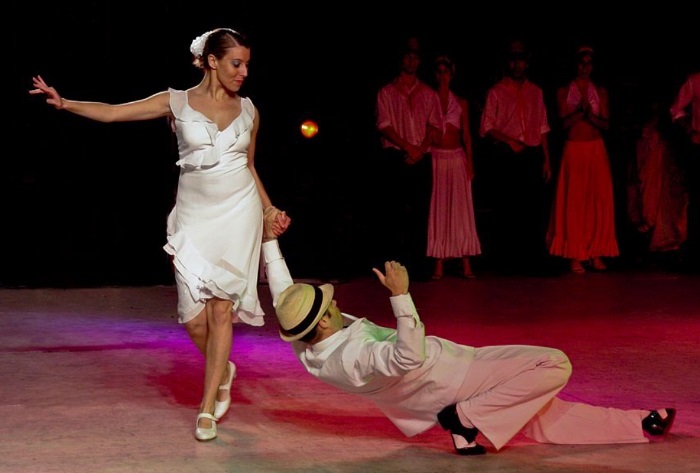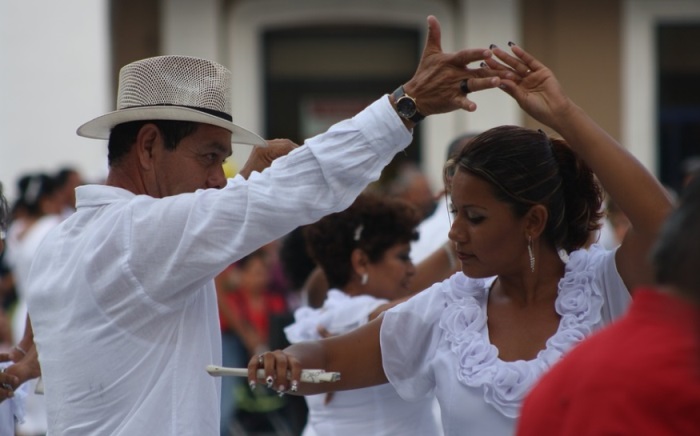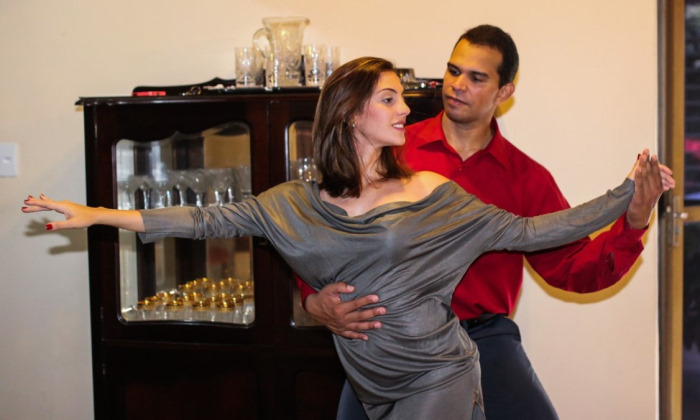The history of Cuba allowed the country to be a converged point of culture, and these exotic traits were eventually blended with the Cuban quintessence to form traditional Cuban dances.
Let’s see what this beautiful nation has to say through body movements and specialized tunes as well as what these dances have to survive the test of time!
Table of Contents
7 Popular Traditional Cuban Dances
When you talk about Cuban dances, you can’t leave Danzón out of the conversation, not when the country has acknowledged it as an official music genre and dance of the land.
Danzón is an evolvement of the Cuban habanera (contradanza) with African rhythms, hence you will find a combination of Europe and Africa in the dance moves.
However, the later Danzón representing more European traits is the one widely acknowledged beyond the realm of the nation.
Originally, Danzón started and repeated with a combination of introduction and paseo. During these parts of the performance, the dancers will take their time sauntering across the dance floor and choosing a partner before initiating the dance at the distinctive fourth beat of the paseo.
Between two repetitions of the dance, they will pause to greet friends or flirt with love interests.
The music of Danzón was heavily based on wind instruments in the early days, though we can still find the sound of a comet, clarinet, violin, and different types.
However, in our time, elegant tunes played by flute, cello, timbales, and more have become more popular.
Son
Often referred to as Son Cubano, the dance and music genre from Eastern Cuba features Spanish and African elements.
It arrived in Havana in 1909, inspired the recordings released in 1917, and quickly spread its influence to the entirety of the Cuban territory.
Being the dance that inspired the Salsa later, Son is remarkably similar to its more popular offspring, even though it is much slower. If you try a few steps, you will notice more energy in them, as well as more accentuation in your hips.
The accompaniment for such steps is African rhythms with bell patterns and percussions, shaped into short melodies or phrases with various pitches in a single composition.
Today, we don’t often hear the traditional Son music because it is assimilated into various styles instead of being an independent dance.
Younger generations find more passion in Son variations such as Salsa or Timba, which are more quick-paced and modernized.
Check more: 10+ Popular Traditional Greek Dances
Mambo

Many sources led us to believe and affirm that Mambo is a derivative of the famous Danzón. In the Latin America region, people even address it as the Danzón – Mambo.
However, the influence of the Son dance on it wasn’t any less important.
In the language of the Kongo slaves transported to Cuba, “Mambo” means “conversations with the gods”. It might explain the music is played mainly by percussion instruments.
In the 1930s, Antonio Arcaño – the leader of the Danzón orchestra – experimentally added an ending with syncopation of Son to the original Danzón.
He and his team called it “Danzón with a new rhythm” before people came up with the name Danzón – Mambo.
The modern Mambo we often see today is a choreography piece accompanying the “Mambo” song written by the López brothers in 1938. It also adopted elements from European dances such as contredanse or contradanza.
Cha-cha-cha
Cha-cha-cha is an authentic creation from Cuba, first introduced with a matching song by Enrique Jorrin. However, in ballroom competitions, it is usually performed with pop or rock in Latin style.
The traditional Cuban dance costumes also come into play, with black for the men and bold colors for the women, preferably red.
The name comes from the rhythm of the güro and the sound when the dancers shuffle their feet. They usually count the beats as “one, two, cha cha cha” rather than “three, three, cha cha cha” so they won’t accidentally get the wrong beats.
Another interesting detail is that the dance doesn’t start as soon as the beats count, but rather the moment the lead shifts their weight to the right foot.
The version taught by the International School of Ballroom Dance is in a four-and-one beat count, including the steps and the hip movements.
An important note here is that the leg holding most of your weight will have to be straight while the upper part of your body remains quite still and controlled.
Bolero
The Cuban Bolero is a traditional Cuban dance music and performance, which means its creation has little to no relation with the Spanish style of the same name.
The beginning of the Cuban Bolero was during the last two or three decades of the 19th century, Santiago de Cuba witnessed a troupe of musicians and singers earning a living with the talents they were blessed with. The father of Bolero was one of them.
Pepe Sánchez composed with his mind and rarely jotted his ideas down on paper, hence we don’t have a lot of records of him and his work anymore, besides a few keepsakes by his friends or students.
However, it was still enough for us to tell he created the trova style and willingly passed the knowledge to his fellow dance lovers.
When you see Bolero in Latin American countries and Mexico, you will find many similarities between it and the Cuban version. It is because Cuba was the birthplace of the dance.
Salsa
Derived and developed from former popular dances such as Mambo and Cha-cha-cha, Salsa took New York by storm in the mid-late 70s.
With inspiration from Afro-Caribbean and Afro-Cuban choreography as well as Hustle and Swing elements, Salsa was incredibly fun and thus successful in attracting many enthusiasts.
The origin of the name “Salsa” can stir quite a ruckus by itself. Some people think the record labels just needed a name connotating something hot and spicy, some insist that the musicians shouted it aloud while playing.
Certainly, some folks believe it is merely a wink back to the multi-ingredient sauce, like how Salsa comprises various dancing styles.
The quintessence of Salsa lies in the core of the dancer as they fixate their upper body almost completely while shifting the weight with steps and motivating the hip movements.
The Cuban Casino version is an exception, with a lot of motions in the shoulders and the part above the waist in general.
A Salsa duo can be in either an open or a closed position.
The open position means they will connect through hand-holding, while the closed position looks more intimate, with the lead putting their arm around the follow’s waist and the follow’s hand on the lead’s shoulder.
Rumba
The most common explanations for the name “Rumba” are “rumbear” and “rumbo”. “Rumbear” means “have a good party” and “rumbo” means “uproar”. Whichever is true, it helps to explain why the rhythm is so important when dancing Rumba.
The Rumba band includes a variety of percussion instruments such as quinto, palitos, tumbadora, and more. There is also a vocal part with a lead singer and a chorus to add more colors to the performance, hence Rumba music has gained quite a reputation for itself.
After a long history, Rumba remains a priceless legacy in Cuban secular dance. The 1985 Minister of Culture in Cuba even declared that Cuba isn’t Cuba without the presence of Rumba.
In competitive scenes, the dance is also considered a national sport.
Being such an acclaimed dance, it is nothing surprising that Rumba has several styles, with three of them often mentioned in discussions.
- Yambú: It is the oldest and slowest style of Rumba. When performed by a solo artist (mostly women), the movements simulate frailty. In a duet, the male can make flirtatious gestures with his partner.
- Guaguancó: Derived from Yambú but with a faster tempo, it is the most popular Rumba style at present and is usually a sexual competition between a pair.
- Columbia: Fast and energetic, Columbia Rumba resembles a contest of men regarding strength, confidence, agility, and sometimes a sense of humor. It used to be a dance for men, yet women have picked it up recently, too.
Final Words
For Cuban people, dancing is an indispensable part of life, and they have been born with a talent for it.
Let it be known that the names in our compilation are only a small part of their legacy, but they are the most important and influential dances that have made the entire world fall in love!





